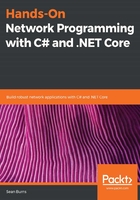
The transport layer
Entities in the transport layer use protocols specifically designed for interacting with other hosts and the network entities in between. It might seem redundant given our description of the presentation and session layer; however, there's an important role to be played here. The presentation layer is concerned with character encoding, or the mapping from platform-specific data representations to platform-agnostic descriptions of that representation. The transport layer, though, looks at the full block of encoded data that was passed down by the presentation layer, and determines how to break it apart. It's responsible for cutting the data into segments of otherwise useless streams of binary. And, importantly, it breaks those segments up in such a way that they can be reassembled on the other side of the connection. The transport layer is also responsible for error detection and recovery, with different protocols providing different levels of reliability.
This layer is the lowest layer in the Host layers umbrella previously described. Determining what transport mechanism can and will be supported by a host remains the responsibility of that host. However, it is the lowest boundary of a given host's responsibility in successfully implementing network interaction. Everything below this layer falls into the Media layer, and is the responsibility of the engineers who support the network that the host has been deployed on.